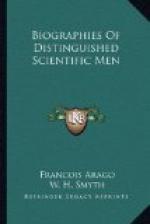Bailly resided in the Louvre. Being determined to make the theory and practice of astronomy advance together, he had an observatory established from the year 1760, at one of the windows in the upper story of the south gallery. Perhaps I may occasion surprise by giving the pompous name of Observatory to the space occupied by a window, and the small number of instruments that it could contain. I admit this feeling, provided it be extended to the Royal Observatory of the epoch, to the old imposing and severe mass of stone that attracts the attention of the promenaders in the great walk of the Luxembourg. There also, the astronomers were obliged to stand in the hollow of the windows; there also they said, like Bailly: I cannot verify my quadrants either by the horizon or by the zenith, for I can neither see the horizon nor the zenith. This ought to be known, even if it should disturb the wild reveries of two or three writers, who have no scientific authority: France did not possess an observatory worthy of her, nor worthy of the science, and capable of rivalling the other observatories of Europe, until within these ten or twelve years.
The earliest observations made by Bailly, from one of the windows in the upper story of the Louvre gallery that looks out on the Pont des Arts, are dated in the beginning of 1760. The pupil of Lacaille was not yet twenty-four years old. Those observations relate to an opposition of the planet Mars. In the same year he determined the oppositions of Jupiter and of Saturn, and compared the results of his own determinations with the tables.
The subsequent year I see him associated with Lacaille in observing the transit of Venus over the sun’s disk. It was an extraordinary piece of good fortune, Gentlemen, at the very commencement of his scientific life, to witness in succession two of the most interesting astronomical events: the first predicted and well established return of a comet; and one of those partial eclipses of the sun by Venus, that do not recur till after the lapse of a hundred and ten years, and from which science has deduced the indirect but exact method, without which we should still be ignorant of the fact that the sun’s mean distance from our earth is thirty-eight millions of leagues.
I shall have completed the enumeration of Bailly’s astronomical labours performed before he became an academician, when I have added, from observations of the comet of 1762, the calculation of its parabolic orbit; the discussion of forty-two observations of the moon by La Hire, a detailed labour destined to serve as a starting point for any person occupying himself with the lunar theory; finally, also the reduction of 515 zodiacal stars, observed by Lacaille in 1760 and 1761.
FOOTNOTE:
[6] This long list of supposed difficulties in making an exact observation is hardly worthy of a zealous astronomer. Our author shows no enthusiasm for his subject here, and ends by ascribing the whole jeremiad to Lacaille, a man of very great practical perseverance. It is to be regretted that Arago never refers to observations of his own, but constantly quotes from others, nor does he always select the best. —Translator’s Note.




